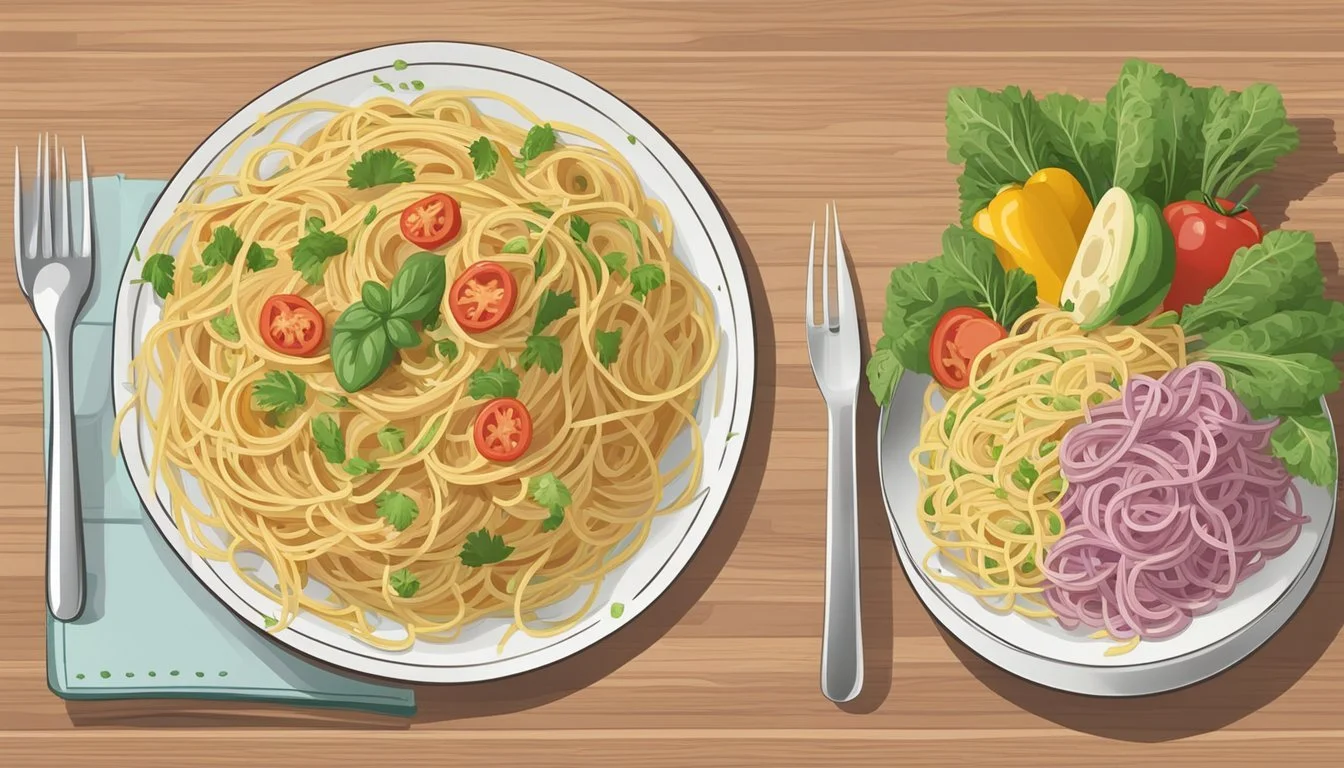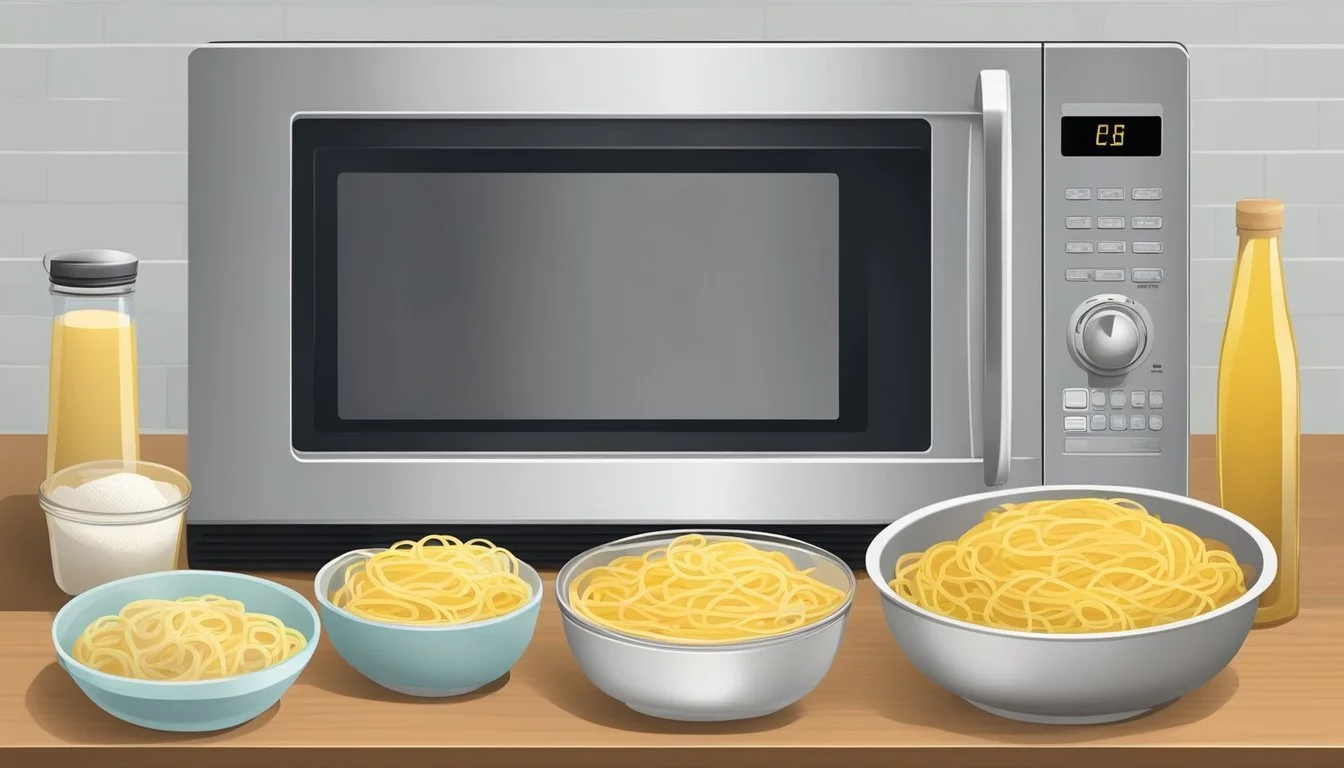Is Spaghetti Carbonara Vegan?
Unveiling the Traditional Recipe Origins
Spaghetti carbonara is traditionally an Italian pasta (What wine goes well with pasta?) dish made from spaghetti, eggs, hard cheese, cured pork, and black pepper. Its creamy texture and rich taste come from the fresh ingredients used, primarily the eggs and cheese, which are not vegan due to their animal origin. This poses a question for those following a plant-based diet or those who are lactose intolerant or allergic to eggs: Can spaghetti carbonara be vegan?
The answer lies in the innovation and adaptability of modern cooking. Vegan chefs and food enthusiasts have crafted a variety of plant-based versions of the classic carbonara. By using vegan substitutes for the non-vegan components, they have managed to create dishes that evoke the essence of carbonara without using animal-derived products. For instance, the eggs can be replaced with a blend of silken tofu and plant-based milk, and the cheese can be substituted with nutritional yeast or a variety of store-bought vegan cheeses designed to mimic the umami flavor and creamy texture. Vegan meat alternatives such as smoked tofu or mushroom bacon can effectively replicate the smoky, savory element traditionally provided by cured pork.
These inventive approaches allow for a spaghetti carbonara experience that aligns with vegan dietary restrictions. While these versions may vary from the original, they expand the dish's accessibility to a wider audience, ensuring that even those on a vegan diet can enjoy a version of carbonara.
Understanding Carbonara
In Italian cuisine, spaghetti carbonara is a beloved dish known for its rich, creamy sauce and savory ingredients. It traditionally includes specific staples that are essential to its unique taste profile.
Traditional Carbonara Ingredients
Ingredients:
Pasta: Typically spaghetti, but other pasta such as fettuccine or rigatoni can be used.
Egg: Whole eggs along with additional yolks provide the base for the sauce.
Cheese: Pecorino Romano or Parmesan cheese, finely grated, is traditional.
Pork: Cured pork in the form of pancetta or guanciale lends a distinctive flavor.
Seasoning: Freshly cracked black pepper is essential for authenticity.
These ingredients combine to define the quintessential carbonara.
Major Components of Carbonara Sauce
Sauce Composition:
Eggs and Cheese: The eggs are beaten, and the cheese is incorporated to create a smooth mixture.
Cured Pork: Pancetta or guanciale is rendered in a pan to release its fats, which will emulsify with the egg and cheese mixture.
Pasta Water: A small amount is often added to adjust the consistency of the sauce, allowing it to cling to the pasta.
Heat Control: The pasta is tossed with the sauce away from direct heat to prevent scrambling the eggs.
These components are meticulously balanced to achieve the creamy textural signature of carbonara sauce without using cream.
Fundamentals of Veganism
Veganism is a dietary practice that excludes all forms of animal products and emphasizes the use of plant-based alternatives. This section discusses the core principles of a vegan diet and the plant-derived substitutes for traditional dairy and meat products.
Principles of Vegan Diet
A vegan diet strictly avoids any animal-derived ingredients. This includes not only meat, fish, and poultry, but also dairy, eggs, honey, and other byproducts like gelatin. The principle is grounded in ethics, environmental concerns, and health considerations. Vegans opt for a variety of fruits, vegetables, legumes, grains, nuts, and seeds to cover their nutritional needs.
Key Nutrients in a Vegan Diet:
Protein: legumes, nuts, seeds, tofu, tempeh
Calcium: fortified plant milks, dark leafy greens, almonds
Vitamin B12: fortified foods, nutritional yeast, supplements
Iron: lentils, chickpeas, quinoa, pumpkin seeds
Omega-3 fatty acids: flaxseeds, chia seeds, hemp seeds, walnuts
Vegan Substitutes for Dairy and Meat
The rise of veganism has led to the innovation of numerous plant-based substitutes that replicate the taste, texture, and nutritional content of dairy and meat.
Dairy-free Alternates:
Milk: soy, almond, oat, coconut, rice milks
Cheese: nut-based cheeses, soy-based cheeses, yeast flakes for a cheesy flavor
Butter: plant-based spreads, avocado, coconut oil
Vegan Bacon and Parmesan:
Vegan bacon alternatives are usually made from tempeh, tofu, or processed vegetable proteins, typically seasoned to mimic the smokiness of traditional pork bacon.
Vegan parmesan can be created using ingredients such as ground nuts, nutritional yeast, and seasonings to achieve a similar umami and texture.
Vegan Spaghetti Carbonara Recipe
Transitioning the classic spaghetti carbonara into a vegan-friendly dish involves creative use of plant-based ingredients to mimic traditional flavors and textures. The recipe outlined here maintains the essence of the original while providing a satisfying meal for vegan diets.
Selecting Vegan Ingredients
For an authentic vegan carbonara, the main components to consider are the pasta and the "eggy" sauce. Starting with the pasta, one must ensure it's egg-free—most dry spaghetti brands are suitable. The carbonara's characteristic flavors are replicated using a combination of nutritional yeast, for a cheesy umami, and black salt (kala namak), which provides the dish with an egg-like savoriness. Olive oil and liquid smoke give the dish a depth of flavor, often achieved through pancetta in the non-vegan version.
Here are the core ingredients for a vegan carbonara:
Egg-free spaghetti
Nutritional yeast
Black salt (kala namak)
Olive oil
Liquid smoke
Preparing Vegan Carbonara Sauce
The sauce is where the magic happens. Traditional carbonara sauce is made from eggs and cheese, which are replaced in vegan versions with a blend of nutritional yeast, non-dairy milk, and a thickening agent like cornstarch. To enhance the sauce, black salt can be used for its eggy flavor, while liquid smoke imparts a hint of smokiness. Mixing in a small amount of soy sauce can also add to the depth of the dish's savoriness.
Here's a quick rundown:
Blend nutritional yeast with non-dairy milk and cornstarch.
Heat the mixture until it thickens, stirring regularly.
Stir in black salt, liquid smoke, and soy sauce to taste.
Cooking and Assembly
The pasta should be cooked in boiling water until al dente—be sure to reserve some pasta water to help emulsify the sauce and achieve the right consistency. To assemble the dish, warm olive oil in a pan and sauté any additional toppings like vegan bacon or mushrooms. Introduce the cooked spaghetti to the pan and toss with the vegan carbonara sauce. The reserved pasta water can be added progressively to reach the desired sauce consistency. Heating everything together for a few minutes ensures the flavors are well-incorporated and the pasta is coated perfectly.
In summary, cook the pasta until al dente, prepare the sauce, then combine and heat through:
Boil the pasta, save pasta water.
Sauté toppings in olive oil, then add spaghetti.
Toss with the vegan carbonara sauce, adding pasta water as needed.
Nutritional Comparison
When comparing traditional spaghetti carbonara to its vegan counterpart, one should consider both caloric content and the macronutrient profile, as well as the vitamins and minerals present in each dish.
Caloric and Macronutrient Content
Traditional spaghetti carbonara typically contains a higher calorie count due to ingredients like eggs, cheese, and pancetta. A vegan version substitutes these with plant-based ingredients, which can alter the caloric and macronutrient content.
Nutrient Traditional Carbonara (per serving) Vegan Carbonara (per serving) Calories Around 400-500 350-450 Protein 15-20g 10-15g Carbohydrates 40-50g 45-55g Fat 15-25g 10-15g Saturated Fat 5-8g 1-2g Sodium 500-1000mg 200-500mg Fiber 1-3g 4-6g Sugar 2-4g 3-5g
The vegan version of spaghetti carbonara is usually lower in saturated fat and cholesterol since plant-based ingredients replace the traditional meats and cheeses. It also often features a greater fiber content due to the inclusion of whole foods like vegetables or legumes. The protein content may vary, but it often comes from sources like tofu, seitan, (What wine goes well with seitan?) or nutritional yeast.
Vitamins and Minerals
Traditional spaghetti carbonara is a source of B vitamins from eggs, as well as minerals like phosphorus and calcium found in cheese.
Vitamin/Mineral Traditional Carbonara Vegan Carbonara Vitamin B12 Present (from eggs) Fortified sources only Vitamin D Present (from eggs) Fortified sources or mushrooms Calcium Higher (from cheese) Variable (depends on fortified ingredients or plant sources) Iron Lower Higher (from plant sources) Phosphorus Present (from dairy) Present (from plant sources) Magnesium Present Present
Vegan carbonara might be fortified with vitamins like B12 and D, depending on the plant-based ingredients and substitutes used. The mineral profile can be enhanced by utilizing a range of vegetables and nuts. For example, cashews, often used for creamy sauces (What wine goes well with creamy sauces?), contribute to magnesium and iron content.
Vegan Cooking Techniques
When crafting vegan versions of traditional dishes like spaghetti carbonara, two key elements are ensuring creaminess without dairy and establishing depth of flavor using plant-based ingredients.
Achieving Creaminess Without Dairy
Traditional carbonara derives its silky texture from a combination of egg and cheese. Vegan cooking, on the other hand, utilizes a variety of plant-based substitutes to mimic this creaminess:
Nuts: Raw cashews, soaked in water, become soft and blendable, forming the basis of many creamy sauces when processed in a blender.
Non-dairy milk: Varieties such as oat, soy, or almond milk can be thickened with flour or other stabilizers to create a rich base for sauces.
To recreate the cheesy flavor, vegan cooks often incorporate vegan parmesan cheese, which can be purchased or homemade using nuts, nutritional yeast, and seasoning.
Vegan Flavor Enhancements
Depth of flavor in vegan cooking can be achieved by:
Garlic: A staple in many cuisines, garlic provides a strong aromatic base that enhances the savoriness of dishes.
Soy sauce and tamari: These fermented condiments add umami, a savory taste that is often lacking in plant-based dishes. They should be used judiciously to avoid overpowering the dish.
Accompanying these flavor enhancers, other ingredients such as smoked paprika or liquid smoke can impart the smokiness typically associated with bacon, a key component in traditional carbonara. These techniques and ingredients ensure that vegan dishes are just as satisfying and flavorful as their non-vegan counterparts.
Serving and Pairing Suggestions
When presenting spaghetti carbonara, especially a vegan version, it is crucial to select side dishes and beverages that complement the flavors without overpowering the delicate balance of the dish.
Side Dishes and Complements
For side dishes, one may consider a simple salad with a light vinaigrette to offset the richness of the carbonara. Cherry tomatoes and arugula make excellent additions, providing a fresh, peppery contrast. Another vegetable to consider is steamed peas, which can add a sweet pop of flavor and a vibrant color to the plate. Garlic bread is often served alongside pasta dishes; in this case, one might opt for a garlic-infused focaccia to maintain the Italian theme. Sprinkling chopped parsley as a garnish not only adds a splash of color but also a fresh, herby layer to the dish. For appetizers, lighter fare such as bruschetta or stuffed tomatoes can serve as an inviting start without overwhelming the palate before the main course.
Salad Options:
Arugula and cherry tomato salad with light vinaigrette
Steamed or sautéed peas
Bread Options:
Garlic infused focaccia
Appetizers:
Bruschetta
Stuffed tomatoes
Wine and Beverage Pairings
Selecting a wine that pairs well with spaghetti carbonara can enhance the dining experience. A crisp white wine such as Pinot Grigio or Chardonnay complements the creamy texture of the sauce while not overwhelming the taste. These wines can cut through the richness and cleanse the palate between bites. For those preferring non-alcoholic options, a sparkling water with a twist of lemon or a mild iced herbal tea can offer a refreshing accompaniment to the meal.
Wine Pairings:
Pinot Grigio
Chardonnay
Non-Alcoholic Beverages:
Sparkling water with lemon
Mild iced herbal tea
Storage and Reheating
When it comes to storing vegan spaghetti carbonara, the key is to maintain its freshness and texture. Adequate storage can prolong the enjoyment of leftovers, while proper reheating can bring them close to the original dining experience.
Preserving Leftovers
Leftovers should be stored in an airtight container to prevent them from absorbing unwanted flavors and odors from the fridge. Vegan carbonara should ideally be refrigerated within two hours of cooking to ensure food safety. The dish can be kept in the fridge for up to two days. To best preserve the quality:
Cool the pasta to room temperature promptly to minimize bacterial growth.
Divide portions into shallow containers to allow even cooling.
Seal containers tightly to retain moisture and flavor.
Best Practices for Reheating Vegan Pasta
Reheating vegan spaghetti carbonara should be done gently to prevent the sauce from separating or becoming grainy. A microwave or stovetop can be used, with the stovetop providing more control:
Microwave:
Place a portion of the pasta in a microwave-safe dish.
Add a small amount of water to rehydrate and ensure even heat distribution.
Cover with a microwave-safe lid or plastic wrap, leaving a small vent.
Heat on medium power, stirring occasionally, until heated through.
Stovetop:
Transfer the pasta to a pan.
Reintroduce a splash of water or vegetable broth to loosen the sauce.
Heat over low to medium heat, stirring frequently until the pasta is warmed evenly.
Vegan Diet Benefits and Challenges
Adopting a vegan diet involves making a significant lifestyle choice that is often associated with a range of health and environmental benefits, as well as facing certain nutritional and social challenges.
Health and Environmental Impacts
Health Benefits:
Reduced Risk of Chronic Diseases: A vegan diet, rich in fruits, vegetables, legumes, and whole grains, can lower the risk of heart disease, hypertension, type 2 diabetes, and certain cancers.
Weight Management: Plant-based diets are typically lower in calories and fat, helping individuals maintain a healthy weight.
Environmental Benefits:
Lower Greenhouse Gas Emissions: Animal agriculture is a significant source of methane and other greenhouse gases. A plant-based diet reduces one's carbon footprint.
Conservation of Water Resources: It takes considerably less water to produce plant-based foods compared to animal products.
Sustainable Land Use: Plant-based diets require less arable land than diets centered on meat, allowing for more sustainable land use and forest preservation.
Challenges:
Nutritional Concerns: Individuals may need to pay special attention to obtain adequate amounts of vitamin B12, iron, calcium, omega-3 fatty acids, and protein, which are less abundant or less bioavailable in plant-based foods.
Transition and Adaptation: Transitioning to a vegan diet can require significant changes in shopping, cooking, and eating habits.
Addressing Common Misconceptions
Misconception: "A vegan diet doesn't provide enough protein." Reality: Individuals can meet their protein needs with plant-based sources, such as lentils, chickpeas, tofu, tempeh, and quinoa.
Misconception: "Vegan diets are not suitable for athletes or those with high physical demands." Reality: Many athletes thrive on a vegan diet, with careful planning to ensure they are meeting their energy and nutrient requirements.
By foreseeing and addressing these challenges, individuals can enjoy the benefits of a vegan diet while minimizing potential risks.








